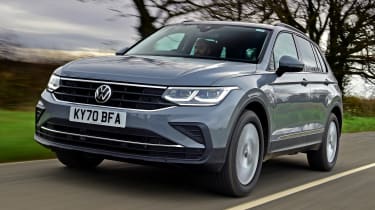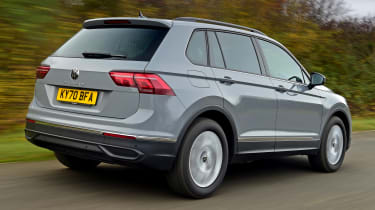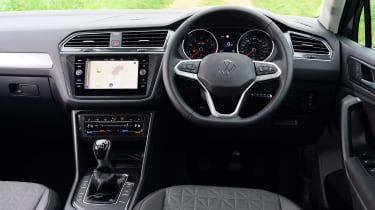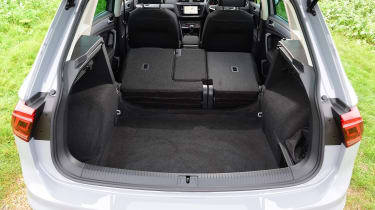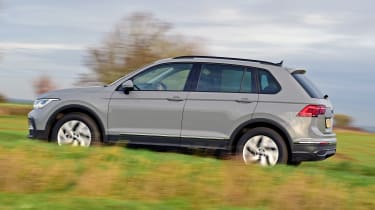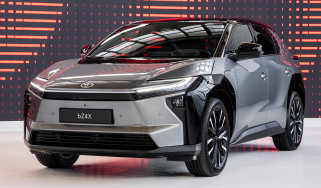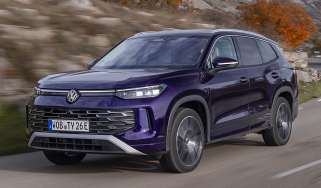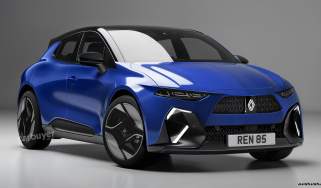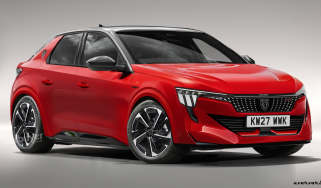Volkswagen Tiguan review (2016-2024)
“The Volkswagen Tiguan is a premium alternative to models like the Nissan Qashqai, with plenty of space and impressive technology and engines”
Pros
- Quiet and smooth on the move
- Large, well shaped boot
- Nicely finished interior
Cons
- Top-spec models expensive
- Not as efficient as some rivals
- Sports suspension is uncomfortable
Verdict - Is the Volkswagen Tiguan a good car?
As a good-looking, practical and well-equipped family SUV, the Tiguan is a great all-round package. It’s more than a match for the Peugeot 3008, so long as you don't mind its conservative looks. The Tiguan’s image is strong too, and you're very unlikely to struggle to find a buyer when it comes time to sell. Our top pick is the quiet 1.5-litre petrol paired with front-wheel drive and a DSG automatic gearbox. In Elegance trim, the car comes loaded with all the kit most families should ever need.
Volkswagen Tiguan models, specs and alternatives
The second-generation Volkswagen Tiguan is a car that doesn’t offer any major advancements over the original but its popularity suggests that it didn't really need to; it's now VW's most popular model globally. The latest version is a popular choice in the medium family SUV market, and it gets sharper styling and upgraded technology thanks to an update in 2020, along with additional engine choices.
Its nose and rear came in for a nip and tuck, plus new technology from the latest Golf was added inside, including an upgraded infotainment system. However, the car is still rather conservative in the styling department compared with rivals such as the Hyundai Tucson and Peugeot 3008, although this might prove to be part of the appeal for some buyers.
Practicality continues to be an important part of the Tiguan's appeal; it makes for a logical step up from a Volkswagen Golf for a growing family. There are clever sliding rear seats and a generous 615-litre boot, in a bid to keep rivals like the Nissan Qashqai, Kia Sportage, Skoda Karoq and premium models including the BMW X1 and Mercedes GLC at bay.
The standard Tiguan comes with a choice of two petrol and a single diesel option. The petrol engine is a 1.5-litre TSI engine with either 128 or 148bhp. It can return around 42-44mpg, with CO2 emissions starting from 145g/km for the less powerful of the two. A more powerful 2.0-litre TSI petrol engine was introduced in early 2021 and was available in 187 or 242bhp power outputs, but this is no longer offered. This engine is fitted with VW’s 4MOTION four-wheel drive system as standard and manages fuel economy of around 32mpg.
More reviews
At this end of the range, you might also be looking at the new Volkswagen Tiguan R range-topper, reviewed separately. It’s easily the most powerful and the fastest, with 316bhp allowing you to get to business meetings or kids’ swimming lessons very quickly. It manages up to 29.7mpg when driven sensibly.
Thanks to their greater fuel economy, diesel engines have traditionally been popular with Tiguan buyers. There have been four to choose from in the past, starting with a good-value 113bhp model, rising to 148bhp and 187bhp, all the way to a twin-turbocharged 237bhp engine that could only be chosen with 4MOTION four-wheel drive and a dual-clutch automatic DSG gearbox. As part of the most recent update, the range has been changed to consist of a new version of the 148bhp diesel with lower CO2 emissions and a 2.0-litre diesel with 197bhp. Currently, only the 148bhp is open for orders. Given that diesels are losing favour, it’s very unlikely that more powerful diesels will be offered.
Electric cars are increasing in popularity, and Volkswagen EV sales targets are aggressive. The manufacturer is well-positioned here, with the Volkswagen ID.4 SUV (with a similar size and focus to the Tiguan) being its best-selling EV. The Tiguan doesn’t offer a fully electric option, but it does offer a plug-in hybrid called eHybrid (supply levels permitting.) It has a petrol engine, electric motor and battery, with an electric range of up to 31 miles.
Trim levels shift for the facelifted car, adopting the same convention as the Golf. For a short while there was an unnamed entry-level version, followed by Life, Elegance, R-Line and R-Line Edition. In March 2023 a Black Edition version also joined the range with black exterior trim, tinted glass and black alloy wheels for a more striking look. Being a Volkswagen, there's an extensive options list, too, and it's easy to take the Tiguan's price tag far higher than where it started.
Importantly for families, the Tiguan achieved a five-star rating in independent Euro NCAP crash-testing, with an impressive 96% score for adult occupant safety and 84% for its protection of younger passengers. The latest Tiguan came 58th in our latest Driver Power owner satisfaction survey.
MPG, running costs & CO2
The Volkswagen Tiguan doesn't have class-leading economy figures, but they're reasonable for the compact SUV class and shouldn't be too hard to stomach. a Nissan Qashqai has smaller engines and – with its greater economy – it’ll be slightly cheaper to run than the Tiguan.
New 'twin-dosing' technology for the diesels’ AdBlue system helps reduce harmful emissions and the Tiguan eHybrid plug-in will be desirable for company-car drivers thanks to its ability to shrink Benefit-in-Kind (BiK) bills.
When equipped with front-wheel drive and the 148bhp version of the 2.0-litre diesel engine, the Tiguan emits from 136g/km of CO2 and returns 54.3mpg. With a seven-speed automatic gearbox this figure drops slightly to 50.4mpg and it emits 145g/km of CO2. The 113bhp 1.6-litre diesel engine was discontinued in 2020.
If it comes back on sale, the more powerful 197bhp diesel should manage similar figures, returning just over 43mpg with emissions of 171-179g/km placing it in the highest BiK band.
The 148bhp 1.5-litre petrol engine is only available in front-wheel drive and returns up to 42.8mpg with CO2 emissions from 149g/km with a manual gearbox, while there’s almost no penalty for choosing the seven-speed DSG automatic. This engine sits towards the higher end of BiK tax bandings for company car drivers. An entry-level 129bhp version of the same engine is also offered at a slightly lower price, but its economy figures of 44.1mpg and 144g/km aren’t a big enough advantage to choose it for any other reason.
When available, the larger 2.0-litre TSI petrol engine was offered in two power outputs and with four-wheel drive and an automatic gearbox. The 187bhp version manages up to 33.2mpg, while the more powerful 242bhp variant (exclusive to the R-Line trim) does 32mpg. Both versions of this engine sit in the top BiK banding for business drivers, with CO2 emissions starting at around 190g/km.
The plug-in hybrid Tiguan eHybrid will appeal to private and business buyers alike, thanks to its ability to drive for up to 31 miles on electricity alone, but a long waiting list and supply issues mean it isn’t always available to order. It uses the same powertrain as the Golf GTE, with 242bhp from its petrol engine and electric motor. As it’s noticeably more expensive than the standard 1.5-litre petrol engine, you’ll need to run on electric power for the majority of the time to recoup savings. For business users, its higher P11D value can be cancelled out by very low BiK rates, although the Volkswagen ID.4 is even cheaper to tax.
Almost all Tiguans incur the standard VED rate but if you add enough options to a top-spec model to push its price above £40,000, you'll have to pay the additional annual surcharge for the first five times you tax the car. The eHybrid is liable for the discounted VED rate as it's classed as an Alternative Fuel Vehicle (AFV).
Insurance groups
Insuring the Tiguan should be relatively affordable, as it sits in groups 15-36 out of 50; models in higher trim levels and with more powerful engines obviously inhabit the higher end of that range. By comparison, the Mazda CX-5 runs from groups 17 to 27, while the BMW X1 starts in group 25 and rises considerably as you head up through the range.
Warranty
The Tiguan has the same three-year/60,000-mile warranty as other Volkswagens, with only the first two years having no cap on mileage. There’s the option of extending this for one or two years.
We think it’s a great shame when companies like Hyundai and Kia can offer five and seven-year warranties respectively, that Volkswagen can’t reflect its reputation for reliability by offering a more generous standard warranty.
Servicing
The Tiguan’s service requirements are similar to those of other models in the Volkswagen group. The recommendation is fixed-interval servicing: once a year or every 10,000 miles, whichever comes first.
This is essential if your car covers low mileage or short journeys where the engine doesn’t always have time to get up to its normal operating temperature. A service plan is available to cover fixed-interval servicing, with pricing available from your dealership.
Alternatively, for higher-mileage drivers, a variable interval scheme can be followed based on wear sensors in the car. This will suit you if you’re likely to exceed 10,000 miles a year and spend most of your time on motorways, driving at sustained speeds where the car doesn’t experience much in the way of fatiguing start-stop urban driving.
Following this regime, the service intervals can be anything between 10,000 and 20,000 miles – but never more than 24 months – between dealer visits.
Engines, drive & performance
The Tiguan won't set pulses racing, but it's very quiet and smooth, especially when fitted with the optional Dynamic Chassis Control, which allows you to adjust how firm the suspension is. When in Comfort mode, these adaptive dampers can make the Tiguan very smooth, even over poor road surfaces and with the larger 20-inch wheels fitted.
The top-of-the-range R-Line trim turns this on its head. While the model's sports suspension means the Tiguan feels more composed at speed and has more agile steering, it's less comfortable over bumps in the road. Unfortunately, however, this sporty suspension setup doesn't completely resolve the car's propensity to lean under heavy cornering.
The steering has plenty of ‘feel’ so the Tiguan is easy to place accurately and with confidence. In general terms, the VW does a good job of isolating you from wind and road noise and feels very car-like and easy to handle.
Volkswagen Tiguan diesel engines
The 148bhp 2.0-litre diesel engine suits the Tiguan well, easily coping with the car’s weight. Volkswagen's DSG automatic gearbox is also smooth and responsive in most situations, but if you put your foot down in a hurry, it can take its time to think about which gear it needs to select. We preferred this engine over the more potent 187bhp diesel, which had a curiously uneven power delivery that made the Tiguan hard to drive smoothly, and is no longer available. It has been replaced with the same 197bhp diesel engine fitted in the Volkswagen Golf GTD.
The more powerful 237bhp twin-turbo diesel was a surprisingly quick car before it was discontinued. The prodigious power available from low revs all the way up the range meant it dealt with overtakes easily.
Petrol engines
For buyers who don’t need four-wheel drive, the 148bhp 1.5-litre petrol engine is arguably the sweet spot of the Tiguan range.
There isn't a huge amount of pulling power to get the Tiguan moving, but above 3,000rpm there's a reasonable turn of speed, with 0-62mph taking nine seconds. The six-speed manual is good, with a light and precise action.
A 2.0-litre petrol engine was also available with two power outputs, four-wheel drive and a seven-speed automatic gearbox as standard. The base 178bhp version is a decent performer, going from 0-62mph in 7.4 seconds, which is a healthy increase over the smaller petrol engine. The 242bhp version has an engine shared with the Golf GTI. This gives the Tiguan a serious performance boost, with 0-62mph taking six seconds.
Volkswagen is also introducing a range-topping Tiguan R that uses the same 2.0-litre petrol turbo engine used in the Cupra Ateca and Volkswagen T-Roc R. Power has been increased to 316bhp and it also gets four-wheel drive, an upgraded chassis and larger brakes to cope with the extra power.
Whichever engine you choose, the Tiguan is a quiet car to travel in. Only the wind rushing around the door mirrors disturbs the calm slightly, although this is by no means intrusive. There’s a little noise from the engines when worked hard, but this is true in all but the most luxurious cars.
Hybrid engine
Unlike VW’s GTE models, the Tiguan eHybrid powertrain is available across several trim levels – when you can get hold of one. It has a combined output of 242bhp, and gets from 0-62mph in a nippy 7.5 seconds. The eHybrid may have a GTE badge next to the gear lever, but it isn’t meant to be a hot Tiguan. Acceleration feels fine, but the six-speed automatic gearbox takes too long to kick down when you want a burst of power. The Tiguan eHybrid is far smoother than many plug-in hybrids when it comes to switching between electric and hybrid power. That smoothness sums up how to drive the Tiguan best; it doesn’t reward heavy acceleration, but keep it at a relaxed pace and it’s very pleasant.
The hybrid Volkswagen Tiguan isn’t quite as fun to drive as the Ford Kuga PHEV, but body roll is kept in check nicely. A ‘B’ mode lets you increase the level of brake regeneration, which harvests more energy to top the battery up when you come to a stop. Our R-Line test car was firm, like petrol and diesel versions, but versions with smaller wheels should be more comfortable.
Interior & comfort
That the new Tiguan’s interior shares much of its design with the latest Volkswagen Golf should come as no surprise. While the dashboard lacks any real design flair, interior quality is easily on par with the Audi Q3 (itself a benchmark in this class) and BMW X1, and is better than a Nissan Qashqai.
Volkswagen Tiguan dashboard
There are some hard plastics lower down on the dashboard and door trims that could be scuffed by passengers’ feet, but it's a very slick and classy layout that should stand up to the test of time well. It is rather plain, however, particularly in the lesser trims, with much less appeal than the Peugeot 3008's interior.
The Tiguan’s infotainment screen is mounted high on the dashboard, which makes it easy to read, and the display and graphics were upgraded as part of the 2020 update. Screens measure up to 9.2 inches in size, and voice controls have also been improved. The climate controls have also been changed for touch-sensitive switches but some may feel the old dials were easier to use. The USB socket is located at the bottom of the centre console, which might prove tricky if you’re trying to connect something in the dark.
Equipment
For the facelift, trim levels changed to match the Golf, with an entry-level version (now discontinued) followed by Life, Active, Elegance, R-Line and Black Edition. Standard equipment includes LED headlights and an updated steering wheel, along with 18-inch alloy wheels, adaptive cruise control, roof rails and climate control. The Elegance and R-Line trims add Matrix LED headlights, digital instruments, a heated steering wheel and the top infotainment setup, along with a panoramic sunroof.
R-Line has 20-inch alloy wheels, interior ambient lighting with 30 colours and features such as a Winter pack. The Black Edition trim was added to the range during 2023, comprising dark tinted rear windows, black exterior trim, a panoramic sunroof and metallic paint. The styling changes are capped off by a set of 20-inch Suzuka Black alloy wheels. It has clearly proved popular, because Volkswagen rolled out the Black Edition to diesel 4MOTION and eHybrid versions during July 2023.
All Tiguan models come with airbags all around, ISOFIX child-seat fixings and lane-keeping assistance.
Technology
Higher Tiguan trims have Digital Cockpit Pro, which is crystal-clear and beautiful to look at. The system, which is similar to the Virtual Cockpit that first appeared in the Audi A4 and Audi TT, can display your current speed, navigation directions and a number of other things; it replaces the analogue speedometer, rev counter and other dashboard dials.
However, the new touch-sensitive climate control panel feels like a step backwards for usability because the smooth strip designed for you to slide with your finger is almost impossible to use while driving. It's a similar problem to the removal of physical shortcut buttons for the central screen; the touch-sensitive ones leave you jabbing at the surface.
Another feature fitted to some models is a head-up display, which can beam the car’s speed and other information into your line of sight. Unlike some similar systems, which bounce the image off the windscreen itself, the Tiguan uses a slightly inelegant glass screen that rises from the top of the dashboard.
All Tiguans come with an eight-inch touchscreen infotainment system as standard, complete with a DAB radio, Bluetooth connectivity, Apple CarPlay and Android Auto. Higher-spec models feature a wi-fi hotspot and VW's Travel Assist semi-autonomous driving technology, which can follow traffic and keep the car in its lane on the motorway.
Practicality & boot space
The new VW Tiguan is more practical than its predecessor. There’s more interior space than before, thanks to this car being both longer and wider than the old one. Rear-seat passengers enjoy more knee and headroom and the back seats can slide back and forth by up to 170mm, allowing you to increase passenger room or boot space as required.
Volkswagen Tiguan interior space & storage
There’s a decent amount of storage up front: each of the door pockets will hold 1.5-litre bottles, while a storage box in the centre console is large enough for a couple of one-litre bottles. There’s also a flock-lined cubby on top of the dash for sunglasses and a rubber-lined area at the base of the centre console.
Boot space
Outright boot space has grown by 145 litres to 615 litres, although this figure is with the rear seats pushed forwards. A variable-height floor is also available which makes it possible to store a laptop out of sight and adds flexibility.
Even so, that’s still a bigger boot than you get in the Nissan Qashqai and Mazda CX-5. The rear seats fold in three pieces, allowing up to 1,655 litres of room. With the rear seats all the way back, the Tiguan’s boot still measures 520 litres, which is pretty good.
That shrinks to 476 litres in the plug-in hybrid, which still beats any Ford Kuga. It’s a smaller size because the hybrid batteries sit under the boot floor.
The boot is easily accessed thanks to a low loading lip and it has a practical, square shape. There are also a few tie-down points to secure smaller items.
Towing
The Tiguan is capable of towing up to 2,500kg, depending on which engine and gearbox you choose. As an optional extra you can specify the Trailer Assist package, which uses the door mirror adjustment joystick to control reverse steering.
Reliability & safety
Volkswagen’s reputation for reliability has taken something of a dive in recent years, so it’ll be interesting to see if the new Tiguan helps to buck this trend.
The Volkswagen Tiguan featured in our most recent Driver Power owner satisfaction surveys, finishing 63rd in 2021, 45th overall in 2022 and ranked 58th in 2023. Owners rated it for seat versatility and its big boot, but most scores were middling. The Tiguan came 48th out of the 75 models included for reliability and build quality.
The survey put the Tiguan behind some of its rivals in the reliability stakes – the Mazda CX-5, Kia Sportage, Honda CR-V and Lexus NX all fared better. The Tiguan’s engine refinement and brakes were also rated lower than some rivals’ by owners.
Safety
The Tiguan received a five-star rating from Euro NCAP when it was crash-tested in 2016. It scored an impressive 96% in the adult occupant protection category, as well as 84% for child occupant protection. Standard equipment includes automatic emergency braking and lane-keeping assistance, together with the usual range of airbags and stability control systems.
Every version of the Tiguan gets an array of standard safety features including Front Assist with City Emergency Braking, which can detect both pedestrians and other vehicles at speeds of up to 19mph and apply the brakes if a hazard is detected. Other useful features include lane assist, which can correct the steering if you drift out of lane and even detect kerbs and grass verges.


